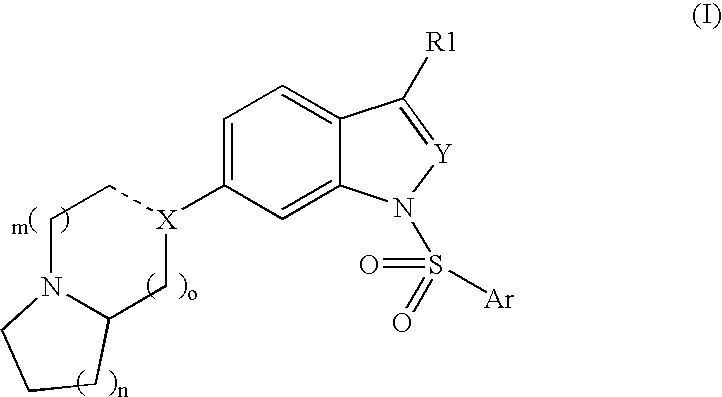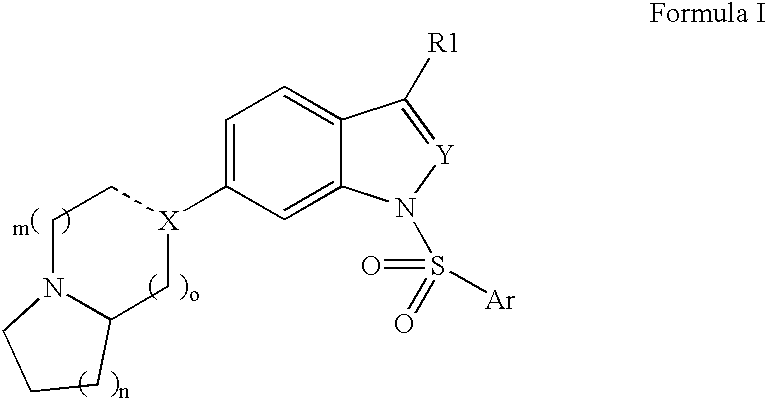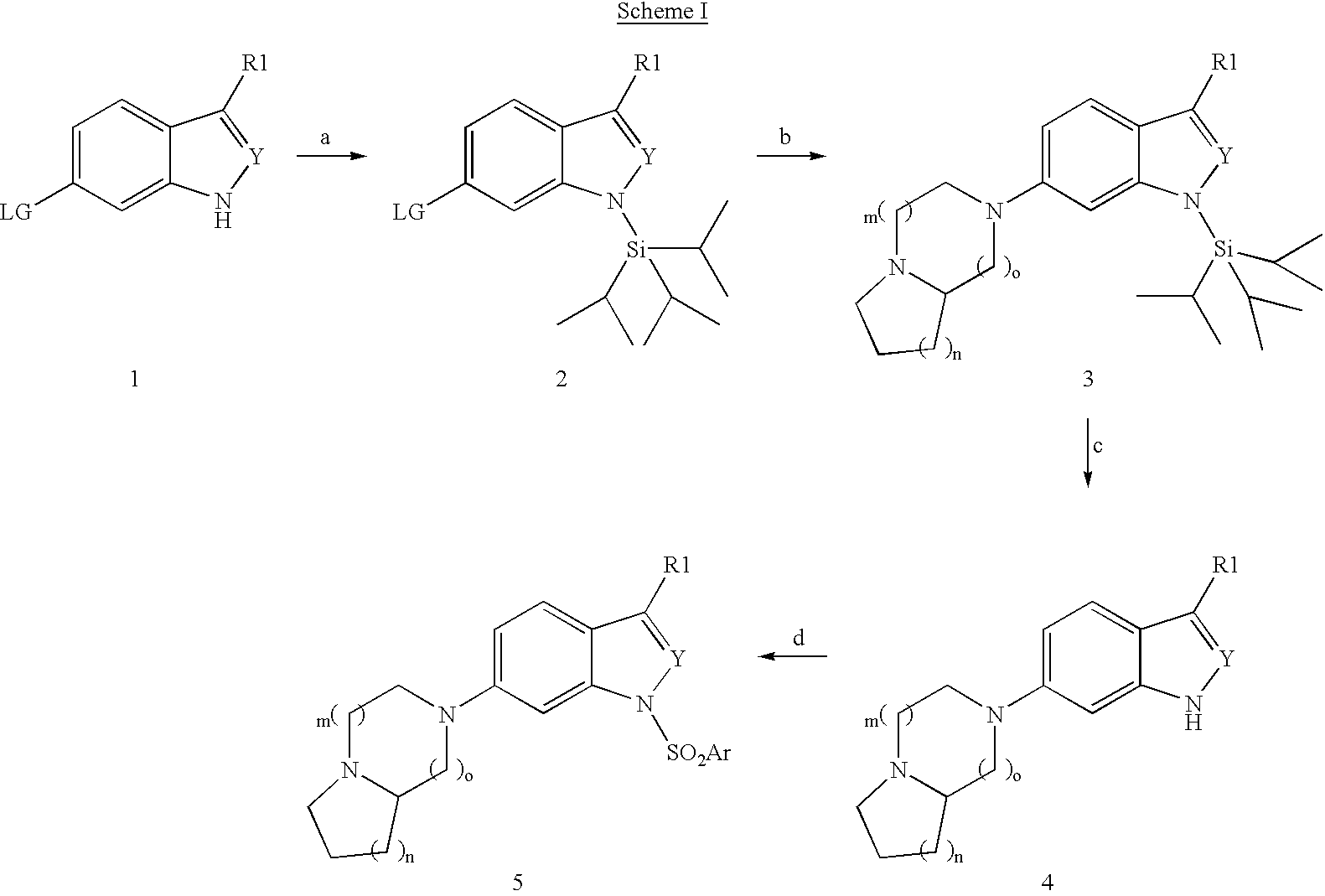Compounds having 5-HT6 receptor antagonist activity
a technology of receptor antagonists and compounds, applied in the field of compound having 5ht6 receptor antagonist activity, can solve the problems of lack of selective agonists and antagonists, and hinder the in vitro investigation of receptor function
- Summary
- Abstract
- Description
- Claims
- Application Information
AI Technical Summary
Benefits of technology
Problems solved by technology
Method used
Image
Examples
example 1
(a) General Procedure for the Synthesis of 6-Bromo-1-triisoproysilylindole (1->2):
[0082]A solution of 6-Bromoindole (1.96 g, 10 mmol) in DMF (5 ml) was added to a suspension of NaH (264 mg, 11 mmol) in DMF (15 ml) at 0° C. The mixture was allowed to stir at this temperature for 15 min after which triisopropylsilyl chloride (2.10 g, 11 mmol) was added dropwise. The mixture was then stirred at room temperature for 2 hrs. The reaction was then poured into ice-cold water followed by extraction with ethyl acetate (2×50 ml). The organic extract was washed with brine, and dried over Na2SO4 (anhydrous). The organic layer was concentrated in vacuo and purified by flash column chromatography giving 2.4 g (68%) of product as a white solid.
[0083]In a like manner the compound 6-bromo-1-triisopropylindazole may be prepared from 6-bromo-indazole by the conditions described above.
General Procedure for the Synthesis of 6-Bromo-1-trimethylsilylethoxymethylindole:
[0084]A solution of 6-Bromoindole (2.8...
example 2
General Procedure for the Amination of 6-Bromo-N-Protectedindole (2->3)
[0086]To a mixture of the N-protected 6-bromo indole produced as described in example 1 (1 eqv.), piperazine (6 eqv.) and sodium t-butoxide (1.4 eqv.) in xylene was added Pd(OAc)2 and P(t-Bu)3 (P / Pd=4). The mixture was heated at 120° C. overnight. The reaction was then poured into ice-cold water followed by extraction with ethyl acetate (2×50 ml). The organic extract was washed with brine, and dried over Na2SO4 (anhydrous). The organic layer was concentrated in vacuo and purified by flash column chromatography. By this process, the following intermediates were obtained:[0087](a) 6-[6,5-bicyclopiperazinyl]-1-trimethylsilylethoxymethylindole (270 mg of a orange oil 36% yield) from 6-bromo-1-trimethylsilylethoxymethylindole (example 1(b)) (652 mg, 2.0 mmol); and[0088](b) 6-[6,6-Bicyclopiperazinyl]-1-triisopropylsilylindole (308 mg of an light brown, 75% yield) from 6-bromo-1-triisopropylsilylindole (example 1 (a)) (...
example 3
General Procedure for the Synthesis of 6-bicyclopiperazinyl-indole:
[0101]To a solution of the indole prepared as described above in Examples 2(a) and 2(b) (1 eqv.) in THF was added dropwise, tetrabutylammonium fluoride (1 eqv). The mixture was allowed to stir at this temperature for 30 min. The solvent was removed in vacuo, and water was added The crude aqueous mixture was then sonicated to give a solid that was filtered. By this process, the following intermediates were obtained:[0102](a) 6-[6,5-Bicyclopiperazinyl]indole (150 mg as a pale yellow solid, 94% yield); and[0103](b) 6-[6,6-Bicyclopiperazinyl]indole (150 mg as a beige solid, 63% yield)
[0104]In a like manner the following compounds are prepared from the corresponding N-protected indole deprotected by the procedure described above:[0105](c) 6-(6,7-bicyclopiperazinyl)-1H-indole[0106](d) 6-(6,8-bicyclopiperazinyl)-1H-indole[0107](e) 6-(7,5-bicyclopiperazinyl)-1H-indole[0108](f) 6-(7,6-bicyclopiperazinyl)-1H-indole[0109](g) 6-...
PUM
| Property | Measurement | Unit |
|---|---|---|
| temperature | aaaaa | aaaaa |
| temperature | aaaaa | aaaaa |
| pH | aaaaa | aaaaa |
Abstract
Description
Claims
Application Information
 Login to View More
Login to View More - R&D
- Intellectual Property
- Life Sciences
- Materials
- Tech Scout
- Unparalleled Data Quality
- Higher Quality Content
- 60% Fewer Hallucinations
Browse by: Latest US Patents, China's latest patents, Technical Efficacy Thesaurus, Application Domain, Technology Topic, Popular Technical Reports.
© 2025 PatSnap. All rights reserved.Legal|Privacy policy|Modern Slavery Act Transparency Statement|Sitemap|About US| Contact US: help@patsnap.com



